December 9, 2024. We were at the final hour of the day at the Royal Enclosure, Hampi. During my earlier visits here I'd seen the stone trough from afar. This time I wanted to check it out closely. Going by its physical form, it looks ideal for storing water from which 8 to 10 horses can drink conveniently at a time. At the end is a small drain hole which comes handy while cleaning.
That's Sridhar checking out the trough. This was his first visit while mine was the sixth.
A board planted next to the trough describes it as follows:
ಕಲ್ಲಿನ ತೊಟ್ಟಿ ಮತ್ತು ಆನೆ ಬಾವಿ ಇವು ರಾಜಸಭಾಂಗಣದ ವಾಯುವ್ಯಕ್ಕೆ ಇವೆ. ಈ ಒಂದೆ ಕಲ್ಲಿನಲ್ಲಿ ಮಾಡಿದ 12 ಮೀಟರ್ ಉದ್ದವಿದ್ದು 2000 ಕೀಟರ್ಗಿಂತಲೂ ಹೆಚ್ಚು ನೀರನ್ನು ಸಂಗ್ರಹಿಸುವ ಸಾಮರ್ಥ್ಯವನ್ನು ಹೊಂದಿದೆ. ಆ ಪ್ರದೇಶದಲ್ಲಿ ಕೆಲಸ ಮಾಡುವ ಅಥವಾ ವಾಸಿಸುವ ಅಧಿಕಾರಿಗಳಿಗೆ ಸೇರಿದ ಪ್ರಾಣಿಗಳಿಗೆ ನೀರನ್ನು ಸಂಗ್ರಹಿಸಲು ಇದನ್ನು ಬಳಸಿರಬಹುದು. ತೊಟ್ಟಿಯು ಒಂದು ಬದಿಯಲ್ಲಿ ಸಣ್ಣ ರಂಧ್ರವನ್ನು ಹೊಂದಿದ್ದು, ನೀರನ್ನು ಸಂಗ್ರಹಿಸುವಾಗ ಅದನ್ನು ಮುಚ್ಚಲಾಗುತ್ತದೆ. ಈ ರಂಧ್ರವು ತೊಟ್ಟಿಯನ್ನು ಸ್ವಚ್ಚಗೊಳಿಸುವಾಗ ಅಥವಾ ತುಂಬಿಸುವ ಮೊದಲು ಅದರಲ್ಲಿದ್ದ ನೀರನ್ನು ಹೊರಗೆ ಹಾಕಲು ಉಪಯೋಗ ವಾಗುತ್ತದೆ. ಈ ತೊಟ್ಟಿಯ ನೈಋತ್ಯಕ್ಕೆ ಆನೆಬಾವಿ ಎಂದು ಕರೆಯಲಾಗುವ ಪುಷ್ಕರಿಣೆ ಇದೆ. ಇದು ಚೌಕಾಕಾರ ವಾಗಿದ್ದು ದಕ್ಷಿಣ ಭಾಗದಲ್ಲಿ ಕಿರಿದಾದ ಮೆಟ್ಟಿಲುಗಳನ್ನು ಹೊಂದಿದೆ. ಅನೇಯ ಶಿಲ್ಪವು ಅದರ ಪಶ್ಚಿಮದಲ್ಲಿದ್ದು, ಅದಕ್ಕೆ ಆನೆ ಬಾವಿ ಎಂಬ ಹೆಸರನ್ನು ನೀಡಿತು. ಪ್ರಾಯಶಃ ಇಲ್ಲಂದ ಕಲ್ಲಿನ ತೊಟ್ಟಿಗೆ ನೀರನ್ನು ಸರಬರಾಜು ಮಾಡಲಾಗುತ್ತಿತ್ತು.
The Large Stone Trough and Elephant Tank are located to the northwest of the Audience Hall. The trough is monolithic and measures 12 m in length, with a capacity of over 2000 litres of water. It might have been used to hold water for animals that belonged to officials working or living in the area. The trough has a small hole on one side of the trough, that is kept plugged while storing water. This hole also allowed for the draining of water prior to cleaning or refilling of the trough. The tank known as Anebavi is located to the southwest of this trough. This tank is square and has narrow steps on the south side. An elephant sculpture, at its west, gave it the name Anebavi (elephant well). It is likely that it supplied water to the trough.
A stone's throw from the trough is a water tank. As you see, its walls are lined with stone blocks and the bottom is mortar floor. This little tank is called as Aane Baavi meaning elephant well. This is convenient for elephants to drink water from.
One of the sides has a small sculpture of an elephant from which water flows into the tank. Now, talking about water supply, Hampi has a vast network of underground canals. The canals supply water to a huge number of temples, Pushkarnis (stepped water tank), bathing houses like the queen's bath and water pavilions where one could cool off during a hot day. I believe water was supplied from Kamalapur lake which is at a slightly higher elevation.
Within the royal enclosure is the ruins of King's Audience Hall. Close to those ruins is a smaller trough ideal for horses to drink from. I guess this trough was filled manually like the larger trough. I guess there are a few more smaller troughs in the sprawling ruins of Hampi.
While on the matter of troughs, I remembered the troughs at Warangal fort. At the fort center is a large enclosure which is an open air museum of Kakatiyan sculptures. Here are the three troughs, two are intact while one has a broken end. While the troughs of Hampi are made of white granite, troughs of Warangal are made of black granite which seems harder.
Want to know more about monuments of Hampae?
Please read- What to see in Hampae.
.........

































































